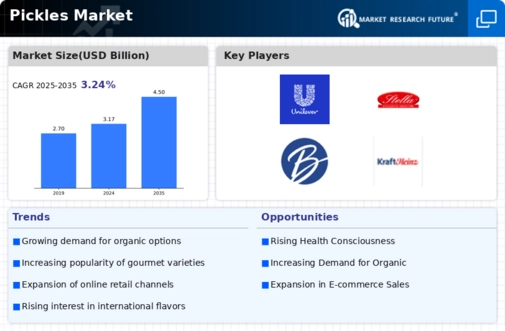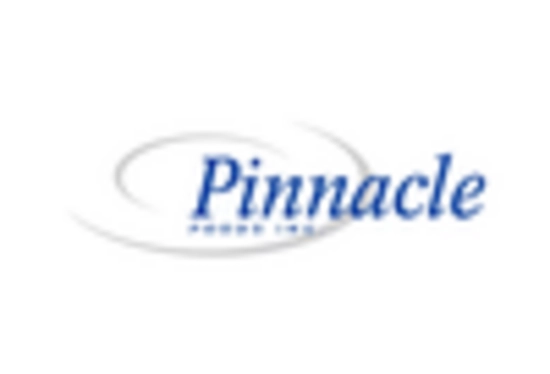Culinary Trends
The evolving culinary landscape is significantly impacting the Pickles Market, as consumers increasingly seek to enhance their meals with bold flavors and unique ingredients. The rise of gourmet cooking at home has led to a greater appreciation for pickles as a versatile condiment that can elevate various dishes. Data indicates that pickles are being used not only in traditional settings but also in innovative recipes, such as gourmet burgers, artisanal sandwiches, and even cocktails. This trend is encouraging manufacturers to explore new applications for pickles, leading to the development of products that cater to culinary enthusiasts. As consumers experiment with pickles in their cooking, the demand for high-quality, unique pickle products is likely to grow. The Pickles Market is thus adapting to these culinary trends, positioning itself as a key player in the modern kitchen.
Flavor Diversity
Flavor innovation is emerging as a significant driver within the Pickles Market. Consumers are increasingly adventurous in their culinary choices, seeking unique and diverse flavors that go beyond traditional dill and sweet pickles. This trend has led to the introduction of a variety of pickle flavors, including spicy, garlic-infused, and even fruit-based options. Market data indicates that specialty pickles are experiencing robust growth, with sales of gourmet and artisanal pickles rising sharply. This diversification not only attracts a broader consumer base but also encourages experimentation in food pairings, enhancing the overall dining experience. As a result, producers are investing in research and development to create novel flavor profiles that resonate with contemporary tastes. The Pickles Market is thus evolving, reflecting a shift towards more complex and varied flavor offerings that cater to the modern palate.
Health Consciousness
The increasing awareness of health and wellness among consumers appears to be a pivotal driver in the Pickles Market. As individuals seek to incorporate more nutritious options into their diets, pickles, which are often low in calories and rich in probiotics, are gaining popularity. According to recent data, the demand for fermented foods, including pickles, has surged, with a notable increase in sales attributed to their perceived health benefits. This trend is further supported by the rise of plant-based diets, where pickles serve as a flavorful accompaniment to various dishes. Consequently, manufacturers are innovating to create healthier pickle options, such as organic and low-sodium varieties, to cater to this health-conscious demographic. The Pickles Market is thus witnessing a transformation, aligning product offerings with consumer preferences for healthier food choices.
Sustainability Practices
Sustainability is becoming an increasingly important consideration for consumers, influencing their purchasing decisions in the Pickles Market. As environmental concerns grow, many consumers are gravitating towards brands that prioritize sustainable sourcing and production practices. This shift is evident in the rising demand for locally sourced ingredients, which not only supports local economies but also reduces the carbon footprint associated with transportation. Market data suggests that products labeled as organic or sustainably produced are witnessing higher sales, as consumers are willing to pay a premium for environmentally friendly options. Consequently, manufacturers are adapting their practices to meet these expectations, focusing on eco-friendly packaging and sustainable farming methods. The Pickles Market is thus responding to this trend, with an increasing number of brands committing to sustainability initiatives that align with consumer values.
Convenience and Accessibility
The demand for convenience is a driving force in the Pickles Market, as busy consumers seek quick and easy meal solutions. Ready-to-eat and shelf-stable pickle products are becoming increasingly popular, as they offer a hassle-free way to add flavor and nutrition to meals without extensive preparation. Market data reveals that sales of packaged pickles are on the rise, particularly in the snack segment, where consumers are looking for healthy, on-the-go options. This trend is prompting manufacturers to innovate packaging solutions that enhance convenience, such as single-serve packs and resealable containers. Additionally, the expansion of distribution channels, including online grocery shopping, is making pickles more accessible to a wider audience. The Pickles Market is thus evolving to meet the needs of consumers who prioritize convenience in their food choices.

















Leave a Comment